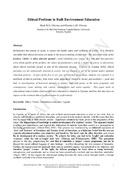| dc.description.abstract | Architecture has among its goals, to ensure the health, safety and wellbeing of society. It is therefore inevitable that ethical decisions are made in the process making architecture. The perceived value of the product, ‘shelter’ is often, taken for granted – until something goes wrong. It is only then that questions arise about quality of the product, the values of practitioners, and as a matter of course, to discussions about ethical positions forged as part of the education process. Contrary to common belief, ethical positions are not intrinsically inherent in society, but are learned as pat of the formal and/or informal education process. As part of the five or six year architecture programme, students are exposed to a multitude of ethical positions, from basic value judgements related to beauty and aesthetics - good and bad; to investigations of historical attempts to portray truth and purity; to the more pragmatic and contemporary issues dealing with context, sustainability and social equality. This paper looks at educational context within which architecture education is situated in Uganda, and how this may have an impact on the eventual ethical positions taken by professionals. | en_US |


